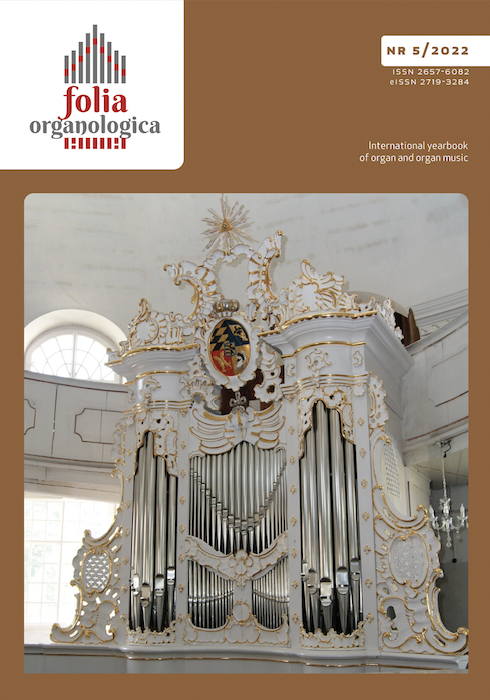Muzyka organowa Ruth Zechlin (1926–2007)
Organ music composed by Ruth Zechlin (1926–2007)
Author(s): Stefania Kazana-BurczykSubject(s): History, Fine Arts / Performing Arts, Cultural history, Music, History of Art
Published by: Uniwersytet Opolski
Keywords: Ruth Zechlin; composer; organist; organ music; modern music
Summary/Abstract: Ruth Zechlin (birth name Oschatz) was born in 1926 in Grosshartmannsdorf in the Weimar Republic. Growing up of a young and talented girl fell on difficult times of war. She developed her musical talents at the beginning under the supervision of musical parents. Then, in the years 1943–1949, she studied at the Higher School of Music in Leipzig – composition with Johann Nepomuk David and organ with Karl Straube and Günter Ramin. After passing the final exams, she joined the university staff for one year. The following year, she was offered a position as lecturer at the East Berlin Conservatory of Music, where she not only taught, but also mastered the harpsichord to an outstanding level. In 1969, she was appointed professor of composition at the Higher School of Music, and two years later she was admitted as a member of the Academy of Arts of the GDR and entrusted to its direction with a composition master class. In addition to her pedagogical activity, Ruth Zechlin was constantly involved in composition. The proof of her compositional versatility is her rich and varied creative output (over 300 compositions). She created instrumental and vocal music, stage works, music for radio plays and television. In the field of instrumental music, a special place is occupied by orchestral works, almost 30 of which were created. Due to her predilection for working on large forms with a rich cast, orchestral works were her favorite genre. In addition, she created concerts, chamber music and compositions for solo instruments. A wide range of instruments – incl. piano, harpsichord, organ, harp, flute, percussion, oboe – indicates a multi-directional musical knowledge, as well as great ease in the selection of the performance apparatus. The composer devoted herself to creating music in the spirit of modernism, drawing on the achievements of authorities such as Stravinsky, Webern, Stockhausen, while shaping her individual style. She drew inspiration from the music of the old masters, and while creating, she used modern compositional means. Religious music occupies a special place in Ruth’s compositional work. It was mostly written in the last period of her life, although she wrote her first religious work when she was 19 (Messe a cappella). It is the only sacred work from this period. In the communist East, composers did not create works of this nature. The cradle of Ruth Zechlin’s religiosity was Bavaria, to which the composer moved with her family. There she met the sincere piety of the Bavarians, and she also met a friend, Bishop Eder. In 1995, she decided to convert from Protestantism to Catholicism. Starting from the 1990s, most of her religious works were created. She repeatedly emphasized their important place: “Mein Wunsch ist es als heute lebender Künstler, mit den Ausdrucksmitteln unserer Zeit wichtige Momente innerhalb der geistlichen Thematik durch meine Musik darzustellen“ – she wanted to express theological aspects through her avantgarde works. In total, she wrote about 40 religious opuses. Organ music was an important area of Ruth Zechlin’s artistic activity. As she herself emphasized, growing up with the works of J. S. Bach, she developed a special passion for this instrument. Zechlin drew inspiration from the virtuosity of her master – J. S. Bach. Passion for playing this instrument resulted in compositional output, including 26 pieces for organ. Her works were influenced by poetry, literature and various events. The Holy Bible became a significant source of inspiration for the artist. Her religious works (including seven pieces for organ) are among the most valued among her entire creative output. Their musical language bears the hallmarks of 20th-century modernism. She shows high creative abilities and the composer’s sensitivity, at the same time setting high reception requirements for the recipient. As wrote P. Tarlinski “contemporary methods of shaping the sound material, such as: dodecaphony, sonorism, aleatorics or series are difficult to perceive.” On the other hand, they are addressed to recipients open to higher culture, valuing their intellect. In Ruth Zechlin’s compositions, one can undoubtedly see aesthetic beauty that will arouse the listener’s feeling towards the piece and its creator and will remain in his memory. The words of F. Chopin – “Happy who can be a composer and performer at the same time (...)” – came true in the life of the artist who often gave concerts. Its activity is undoubtedly confirmed by the renaissance of organ music that took place in the 20th century.
Journal: Folia Organologica. International yearbook of organ and organ music
- Issue Year: 2022
- Issue No: 5
- Page Range: 108-126
- Page Count: 19
- Language: English, Polish

